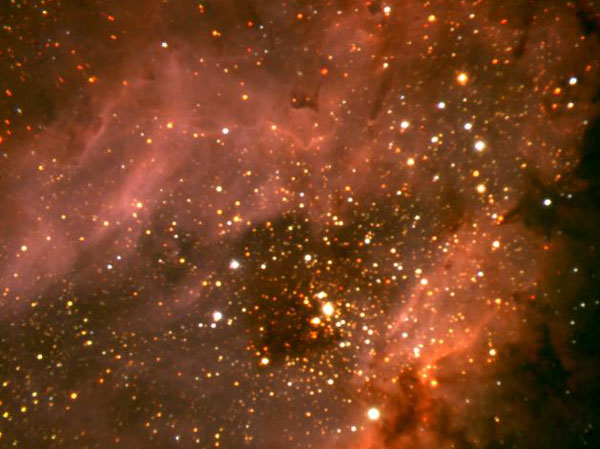
|
Explanation: The Omega Nebula is a massive, complex cloud of dust and gas from which new stars are continually forming. The similarity to the Greek letter capital Omega gives the molecular cloud its popular name, but the nebula is also known as the Swan Nebula, the Horseshoe Nebula, and M17. Detailed features such as thin filaments of emission by diffuse dust and dark clouds of absorption by dense dust are visible in this recently released picture. The image highlights infrared light emitted by large molecules known as polycyclic aromatic hydrocarbons (PAHs), a gas similar to car exhaust that traces carbon and interstellar dust. PAHs may be an intermediate step between smaller molecules and large interstellar dust grains. The origin of PAHs is currently unknown but thought by some astronomers to form in the cool atmospheres of young carbon stars and to be dispersed by their stellar winds.
|
January February March April May June July August September October November December |
| ||||||||||||||||||||||||||||||||||||||||||||||||
NASA Web Site Statements, Warnings, and Disclaimers
NASA Official: Jay Norris. Specific rights apply.
A service of: LHEA at NASA / GSFC
& Michigan Tech. U.
Based on Astronomy Picture
Of the Day
Publications with keywords: M 17 - PAHs - star formation - Omega nebula
Publications with words: M 17 - PAHs - star formation - Omega nebula
See also:
- APOD: 2025 December 9 B The Heart of the Soul Nebula
- APOD: 2025 July 10 B Lynds Dark Nebula 1251
- APOD: 2025 June 23 B W5: Pillars of Star Formation
- APOD: 2025 April 28 B Gum 37 and the Southern Tadpoles
- APOD: 2025 March 26 B Star Formation in the Pacman Nebula
- APOD: 2024 October 22 B M16: Pillars of Star Creation
- Star Factory Messier 17
